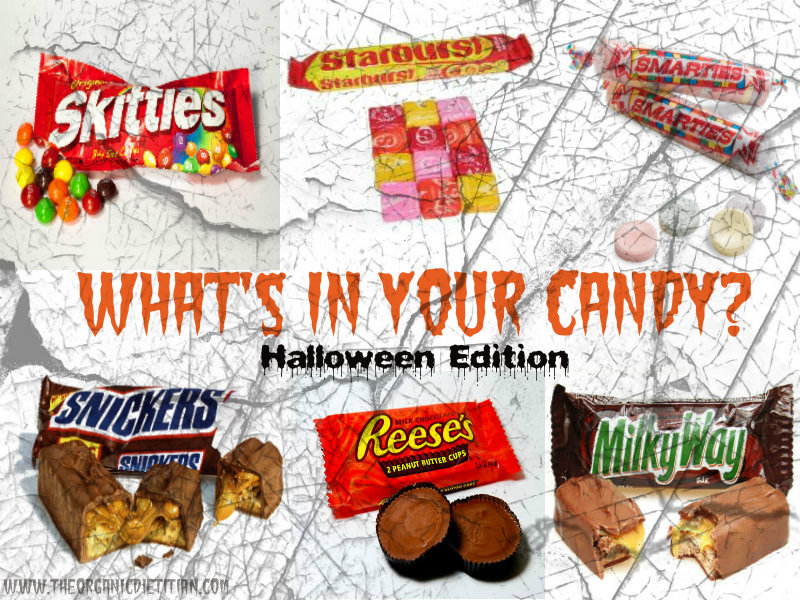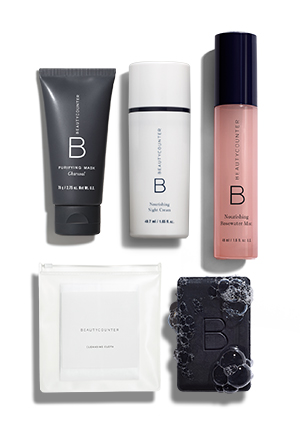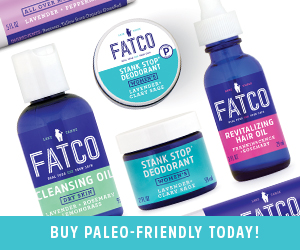6 October, 2013
What’s in Your Candy?: Halloween Edition

Halloween is the start of the holiday season. When I think about Halloween as a kid in Illinois, I mostly remember freezing while walking around the neighborhood. All of this trouble just to collect candy from house to house. I was one of those kids that brought out my candy bag every day after school and ate many pieces at a time. My candy never lasted long, but my sister was the opposite and hers would often last her until the next Halloween. After I finished my candy I would normally try to get some of hers too.
My favorite candies were Skittles or Starburst. I tend to enjoy the fruit-flavored candies over the chocolate bars. I ate my fair share of candy, but the days of Snickers and Milky Way (unless homemade) are over for me. Americans purchase 598 million pounds of candy (or $1.9 billion dollars worth) during the Halloween season. That is a lot of sugar and chemicals that we are putting into our bodies, and the bodies of our growing children. I wanted to take a look as some popular Halloween candies ingredients and find out why they are used and possible effects of eating them. Do you know what’s in your Halloween candy? This may surprise you.
Skittles
Sugar, corn syrup, hydrogenated palm kernel oil, apple juice from concentrate, less than 2% – citric acid, dextrin, modified corn starch, natural and artificial flavors, coloring (includes yellow 6 lake, red 40 lake, yellow 5 lake, blue 2 lake, yellow 5, red 40, yellow 6, blue 1 lake, blue 1), ascorbic acid (vitamin c).
Starburst
Corn syrup, sugar, hydrogenated palm kernel oil and/or palm oil, fruit juice from concentrate (apple, strawberry, lemon, orange, cherry), less than 2% – citric acid, dextrin, gelatin, food starch-modified, natural and artificial flavors, ascorbic acid (vitamin c), coloring (red 40,yellow 6, yellow 5, blue 1).
Smarties
Dextrose, Citric Acid, Calcium Sterate, Artificial Flavors and Colors (FDC Red 40 Lake, Blue 1 Lake, Blue 2 Lake, Yellow 5 Lake, Yellow 6 Lake)
Snickers
Milk Chocolate (Sugar, Cocoa Butter, Chocolate, Skim Milk, Lactose, Milkfat, Soy Lecithin, Artificial Flavor), Peanuts, Corn Syrup, Sugar, Milkfat, Skim Milk, Partically Hydrogenated Soybean Oil, Lactose, Salt, Egg Whites, Chocolate, Artificial Flavor. May Contain Almonds (make my homemade version instead).
Reese’s Peanut Butter Cups
Milk Chocolate (Sugar; Cocoa Butter; Chocolate; Nonfat Milk; Milk Fat; Lactose; Soy Lecithin; PGPR, Emusifier); Peanuts; Sugar; Dextrose; Salt; TBHQ (Preservative)
Milky Way
Milk Chocolate (Sugar, Cocoa Butter, Skim Milk, Chocolate, Lactose, Milkfat, Soy Lecithin, Artificial Flavor), Corn Syrup, Sugar, Hydrogenated Palm Kernel Oil And/Or Palm Oil, Skim Milk, Less Than 2% – Milkfat, Cocoa Powder Processed With Alkali, Malted Barley, Lactose, Salt, Egg Whites, Chocoalte, Artificial Flavor. (make my homemade version instead).
M&Ms
Milk Chocolate (Sugar, Chocolate, Cocoa Butter, Skim Milk, Milkfat, Lactose, Soy Lecithin, Salt, Artificial Flavor), Sugar, Less Than 2% – Cornstarch, Corn Syrup, Coloring (Includes Yellow #5 Lake, Red #40 Lake, Blue #1 Lake, Yellow #6 Lake, Blue #2 Lake, Blue #1, Blue #2, Red #40, Yellow #5, Yellow #6), Dextrin
Knowing what your ingredient list means is a very important step in making better decisions at the grocery store and when making your own food.
1. Sugar – Sugar is made mostly from cane sugar and beet sugar. Beet sugar is one of the most highly genetically modified foods. Sugar is nutrientless and provides excessive, unneeded calories. Consumption of large amounts over time has been linked to tooth decay, obesity, hyperactivity, B vitamin deficiencies, heart disease, and type 2 diabetes. There are many different names for sugar, so be sure you are familiar with them.
2. Corn Syrup – Corn syrup is another highly genetically modified foods. Making corn into corn syrup is a multiple step process that involves adding enzymes to cornstarch and water. Corn syrup is another form of sugar with no nutrient value that can cause weight gain, which can lead to various diseases.
3. Hydrogenated Palm Kernel Oil – Anything hydrogenated is a big red flag. This means trans fat. Trans fat is polyunsaturated vegetable oil that has been partially converted
4. Citric Acid – Citric acid is used as a flavoring and preservative. It is made from citrus fruits, or by fermenting yeast or mold. Citric acid may contain MSG and it may also be genetically modified.
5. Dextrin – Dextrin is often made from cornstarch, so if you are avoiding GMOs then this is a potential violator. In the textile industry dextrin is used to increase the weight and stiffness of fabric.
6. Modified Corn Starch – Seems like everything these days is made from corn and genetically modified corn at that. Corn starch is put through a chemical process to get the end result of Modified Corn Starch.
7. Natural Flavor – Or Castoreium, also known as beaver anal gland juice. This additive is excreted from the caster sacs of mature North American and European beavers. This ingredient can be found on food listed as “natural flavoring.”
8. Artifical Flavor – Artificial flavors are chemical mixtures that are created to make a flavor as close to the real thing as possible. There are hundreds of chemicals that can be used.
9. Arificial Food Dyes – These colors like Red #40, Yellow #5, and Blue #2 are lab created using chemicals from petroleum. They have been linked to cancer and hyperactivity in children. The UK required a warning label on food containing artificial food colors, but companies often avoid having to do this by using natural coloring like paprika.
10. Ascorbic Acid – Ascorbic Acid is a preservative used to prevent spoilage in packaged foods. Ascorbic acid is essentially a chemical compound that acts like vitamin C, but it is not a natural source of vitamin C.
11. Calcium Sterate – This is created by heating fat and calcium oxide. It is used as a flow agent in powders and surface conditioner in hard candies. Calcium Sterate is a main component of soap scum.
12. Soy Lecithin – Soy Lecithin is made from soy oil, which is made in a chemical process using hexane. Soy is another commonly genetically modified ingredients. It is used is many products as an emulsifier to keep ingredients from separating.
13. Partically Hydrogenated Soybean Oil – This is another soy-made product that is likely genetically modified. Partially hydrogenated means Trans Fat, which should be avoided in any amount.
14. Milk Fat and Skim Milk – Cows from these dairy products may have been treated with hormones. Skim milk often has dry milk powder added to it, which may contain rancid components that can contribute to inflammation. Inflammation can lead to other diseases.
15. PGPR – This is used by chocolate makers to reduce their costs of raw materials. It is made from castor oil and replaces the more expensive cocoa butter.
The FDA regulates use of food additives and says, “Because of inherent limitations of science, FDA can never be absolutely certain of the absence of any risk from the use of any substance. Therefore, FDA must determine – based on the best science available – if there is a reasonable certainty of no harm to consumers when an additive is used as proposed.”
So because the FDA has limited resources they are unable to be 100% sure that these food additives are safe.
Make a pledge that this Halloween you will make it a candy-free day for you, your family, and your neighbors. I have put together a list of inexpensive alternatives you can hand out instead of traditional candy tricks or treats.
Healthy Halloween Alternatives









